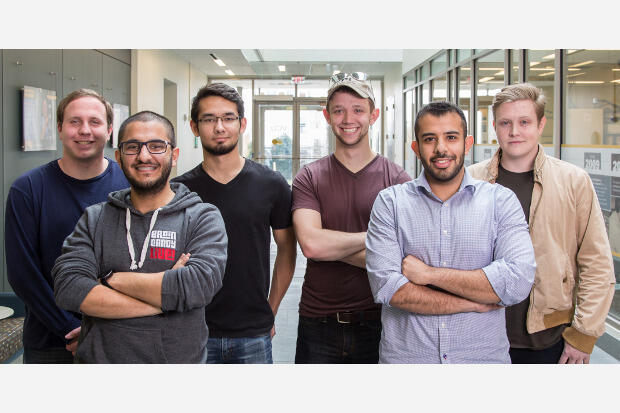
March 31, 2017
New capstone collaboration: Engineering and business students join forces to build startups
Share this story
Students in the Virginia Commonwealth University School of Engineering’s Capstone Design course are building entrepreneurship skills alongside students in the VCU School of Business thanks to a new program that teaches engineering and business students how to create a startup.
VCU Engineering’s yearlong Capstone Design course immerses all senior engineering students in the hands-on process of solving real-world problems. This year, 11 VCU Engineering Capstone Design teams have also joined the business school’s two-semester entrepreneurship capstone course, New Venture Strategy and Initiation, to learn the process of launching a new company. The goal is a cross-disciplinary learning experience that results in innovative products — and viable platforms for getting them to consumers. The engineering and business students will team up to present their innovations at the School of Engineering Capstone Expo on April 28 at VCU’s Stuart C. Siegel Center.
In real life, business and engineering do this by working together.
Engineering capstone teams that have health science, nonprofit or government sponsors for their projects were eligible to participate. Bennett Ward, Ph.D., associate professor and director of project outreach at the VCU School of Engineering, said the program is enriching the engineering capstone experience by giving students a route to commercializing their innovations. It is also prompting them to engage in the kind of business-engineering collaboration they will encounter frequently after graduation.
“At VCU, our motto is ‘Make it real,’ and this partnership does that by creating a mechanism for students to take products to market,” Ward said. “In real life, business and engineering do this by working together. Innovation and commercialization is never one person working on it alone.”
Translation is one of the keys to successful innovation, according to Ward and Susan Coombes, Ph.D., associate professor of management and entrepreneurship capstone course instructor. The two groups don’t always speak the same language, so “user experience,” for example, can mean one thing to businesspeople and something else to engineers.
“We’ll hear, ‘This product is really easy to use,’ but if it’s only easy for engineers, it has to change,” Coombes said. “We push them to develop as much understanding of the other side as possible.”
Students also test assumptions about their products, including whether an idea really is an innovation and not an imitation. Coombes said a quick Google search often shows that inventions are already out there in some form.
“But often these are still good ideas with industry potential,” she said. “Students do a lot of research, and we talk a lot about incremental innovation.”
Ward said identifying unmet needs often leads to ideas for reimagining products. Examples from this year’s engineering teams include a diagnostic device that determines in 10 minutes whether a heart attack has occurred — an improvement over the up-to-24 hours currently required for diagnosis, as well as a ventilator tool caddy that keeps patient breathing tubes safely in place and a new training app for anesthesia students.
“These are big improvements to things that already exist,” Coombes said. “Then the question is: How do you turn it into a business?”
|
Venture Creation University Venture Creation University is VCU's strategy for ensuring all students are exposed to innovation and entrepreneurship and have access to entrepreneurial pathways. To find out more about this effort, and to learn about innovation and entrepreneurial programs offered at VCU, visit entrepreneurship.vcu.edu. |
Jay Markiewicz, executive director of entrepreneurship programs in the School of Business, teaches the second half of New Venture Strategy and Initiation, which pushes students to answer that question.
“In the second half of the course, we say, ‘Let’s focus on the startup, not the product,’” he said.
Markiewicz defines a startup as a delivery platform for a product, and said that platform has to include how the startup will make money and reach customers, what channels it will use and how it will grow.
“We also promote the use of story behind a product,” Markiewicz said. “Our goal is for the business and engineering students to feel the conviction that comes from the story, which is what makes us take action. We find that entrepreneurs often solve problems that they have themselves, and then solve those problems for others.”
The startup’s story, mindset, activities and financials are distilled into a carefully thought-out seven-minute pitch to investors.
“We know we want students to take their products to the market, but that’s a secondary aim. The primary aim is to build cross-disciplinary thinking,” Markiewicz said. “The bet we are making is that there will be better innovation with engineering and business working together.”
Subscribe for free to the VCU News email newsletter at http://newsletter.news.vcu.edu/ and receive a selection of stories, videos, photos, news clips and event listings in your inbox every Monday and Thursday.
Subscribe to VCU News
Subscribe to VCU News at newsletter.vcu.edu and receive a selection of stories, videos, photos, news clips and event listings in your inbox.













